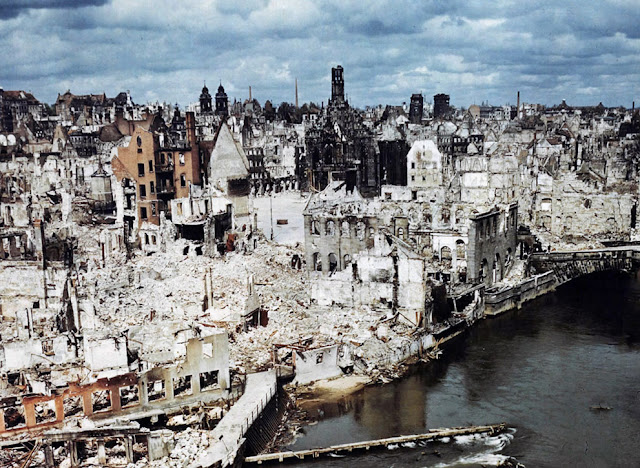Ενα ενδιαφέρον φωτογραφικό οδοιπορικό από την πτώση της Γερμανίας και την ολοσχερή καταστροφή του Βερολίνου στον β΄ παγκόσμιο πόλεμο
A formation of B-24s of Maj. General Nathan F. Twining's U.S. Army 15th Air Force thunders over the railway yards of Salzburg, Austria, on December 27, 1944. The smoke created by their bombs mingles with that from the enemy's many smudge pots.
Low flying C-47 transport planes roar overhead as they carry supplies to the besieged American Forces battling the Germans at Bastogne, during the enemy breakthrough on January 6, 1945 in Belgium. In the distance, smoke rises from wrecked German equipment, while in the foreground, American tanks move up to support the infantry in the fighting.
A view taken from Dresden's town hall of the destroyed Old Town after the allied bombings between February 13 and 15, 1945. Some 3,600 aircraft dropped more than 3,900 tons of high-explosive bombs and incendiary devices on the German city. The resulting firestorm destroyed 15 square miles of the city center, and killed more than 22,000.
Men of the American 7th Army pour through a breach in the Siegfried Line defenses, on their way to Karlsruhe, Germany on March 27, 1945, which lies on the road to Stuttgart.
War-torn Cologne Cathedral stands out of the devastated area on the
west bank of the Rhine, in Cologne, Germany, April 24, 1945. The
railroad station and the Hohenzollern Bridge, at right, are completely
destroyed after three years of Allied air raids. (AP Photo)
Adolf Hitler decorates members of his Nazi youth organization "Hitler Jugend" in a photo reportedly taken in front of the Chancellery Bunker in Berlin, on April 25, 1945. That was just four days before Hitler committed suicide. Compounds erected by the Allies for their collections of prisoners never seem to be big enough, here is an over-crowded cage of Germans rounded up by the Seventh Army during its drive to Heidelberg, on April 4, 1945.
The wrecked Reichstag building in Berlin, Germany, with a destroyed
German military vehicle in the foreground, at the end of World War II. (AP Photo)
A color photograph of the bombed-out historic city of Nuremberg, Germany in June of 1945, after the end of World War II. Nuremberg had been the host of huge Nazi Party conventions from 1927 to 1938. The last scheduled rally in 1939 was canceled at the last minute due to a scheduling conflict: the German invasion of Poland one day prior to the rally date. The city was also the birthplace of the Nuremberg Laws, a set of draconian antisemitic laws adopted by Nazi Germany. Allied bombings from 1943 until 1945 destroyed more than 90% of the city center, and killed more than 6,000 residents. Nuremberg would soon become famous one last time as the host of the Nuremberg Trials -- a series of military tribunals set up to prosecute the surviving leaders of Nazi Germany.

"Raising a flag over the Reichstag" the famous photograph by Yevgeny
Khaldei, taken on May 2, 1945. The photo shows Soviet soldiers raising
the flag of the Soviet Union on top of the German Reichstag building
following the Battle of Berlin. The moment was actually a re-enactment
of an earlier flag-raising, and the photo was embroiled in controversy
over the identities of the soldiers, the photographer, and some
significant photo editing. More about this image from Wikipedia.
πηγη









Σχόλια
Δημοσίευση σχολίου
Ο σχολιασμός του αναγνώστη (ενημερωμένου η μη) είναι το καύσιμο για το ιστολόγιο αυτό, έτσι σας προτρέπουμε να μας πείτε την γνώμη σας. Τα σχόλια οφείλουν να είναι κόσμια, εντός θέματος και γραμμένα με Ελληνικούς χαρακτήρες (όχι greeklish και κεφαλαία).
Καλό είναι όποιος θέλει να διατηρεί την ανωνυμία του να χρησιμοποιεί ένα ψευδώνυμο έτσι ώστε σε περίπτωση διαλόγου, να γίνεται αντιληπτό ποιος είπε τι. Κάθε σχόλιο το οποίο είναι υβριστικό η εμπαθές, θα διαγράφεται αυτομάτως.